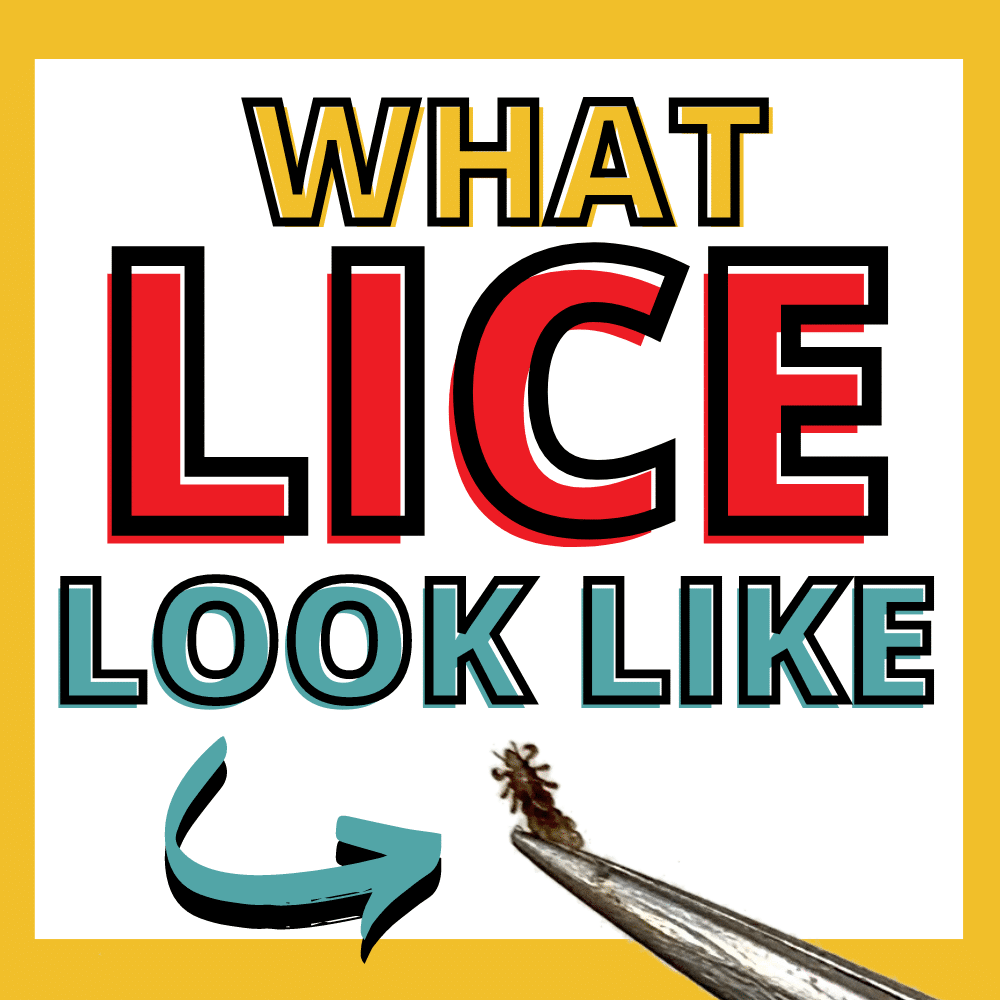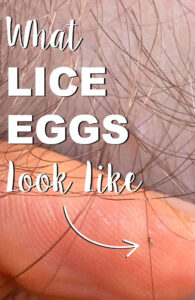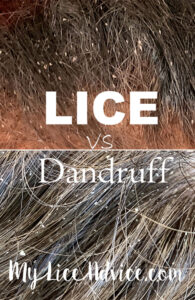What Lice Look Like:
Pictures of Head Lice
(Lice Color, Size, and More)
Question:
What do head lice look like?
Answer from a Lice Expert:
You can easily identify lice using these these five distinct features: color, shape, size, lice eggs, and symptoms.

This article has over 30 pictures or lice, so you'll be a pro in no time...
Lice Color
See all the different colors of head lice in the pictures below.
Lice Shape and Distinct Features
Check out the pictures below detailing the distinct features of head lice.
Head Lice Actual Size
Check out these pictures showing the actual size of lice compared to a coin and on the tip of a finger.
Lice Signs and Symptoms
View pictures of specific lice signs and symptoms like the "lice rash".
Let me introduce myself...
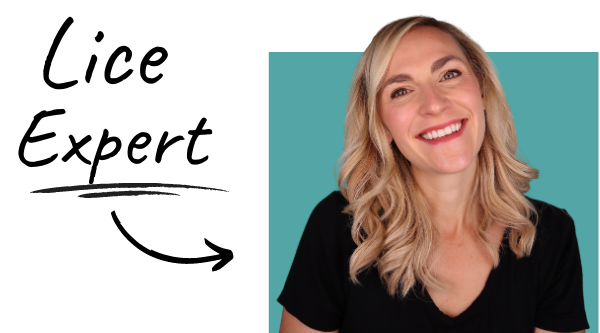
Hi there! I'm Theresa, I'm a lice expert, lice coach, and Registered Nurse. I help people with lice every day! You can get rid of lice in ONE DAY at home by using the same proven professional technique that I use in my lice center.
Just follow the step-by-step videos and be done with lice by the end of the day.
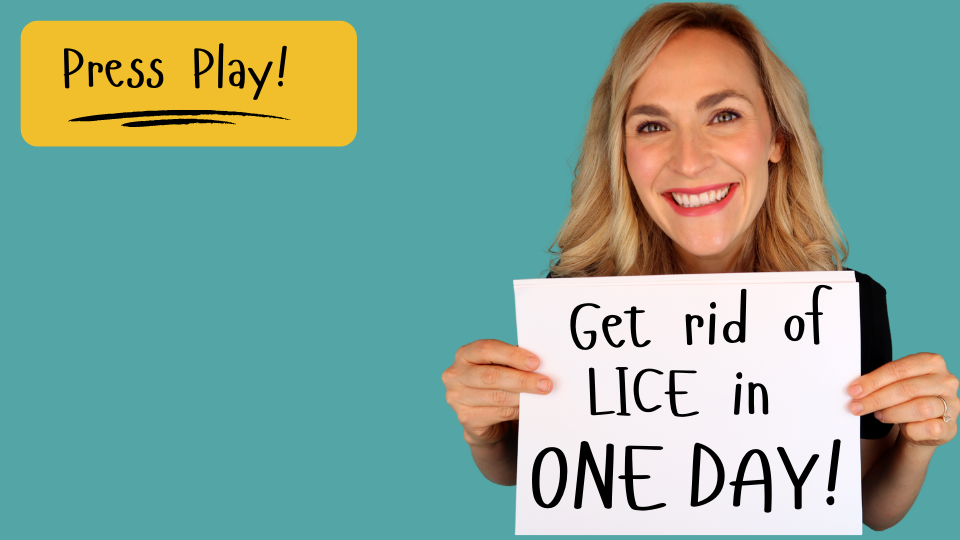
Head Lice – The Basics
There are three types of lice that can live on humans: head lice, body lice, and pubic lice. Head lice is by far the most common, affecting about 12 million Americans every year. It is the second most common childhood ailment in the US, second only to the common cold.
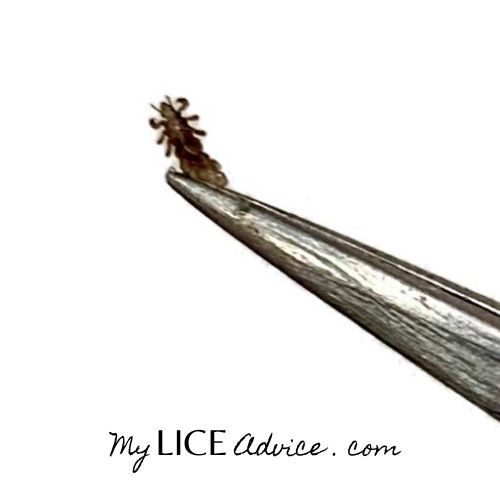
Head lice live exclusively in human hair and rarely come off the head unless physically removed. They feed on human blood several times a day, but fortunately do not spread diseases. Head lice are no respecter of persons, and anybody can get head lice, no matter their age, race, or cleanliness.
Though this is far from typical, here is an example of a severe (and obvious) head lice infestation:
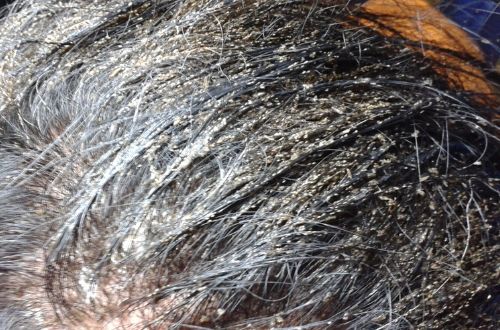
Super Lice
A fourth type of lice making big news these days is a new strain of head lice: super lice. Super lice and regular head lice are virtually the same bugs, except super lice have mutations that make them (and their eggs) extremely difficult to kill. These super lice are becoming the “new” and more prominent strain of head lice.
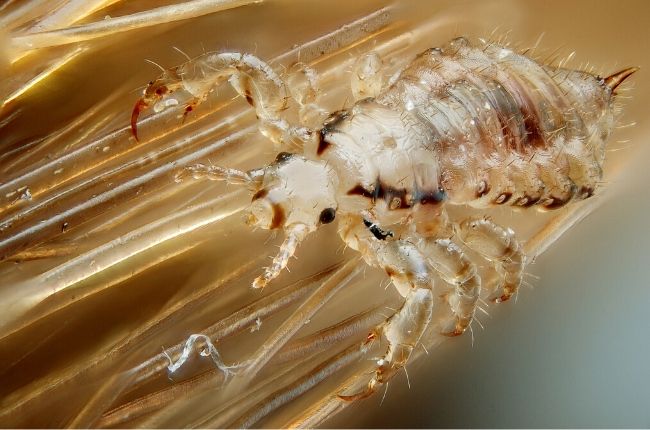
How Can You Tell The Difference Between Regular Head Lice and Super Lice?
Regular head lice and super lice look and act exactly the same; the only difference is that super lice will not die using traditional treatments. Unfortunately, almost all lice in the world today are now immune to over-the-counter treatments. The most recent studies in the US show that 98% of lice are "super lice" which means that they are resistant to traditional lice treatments.
Lice In Hair
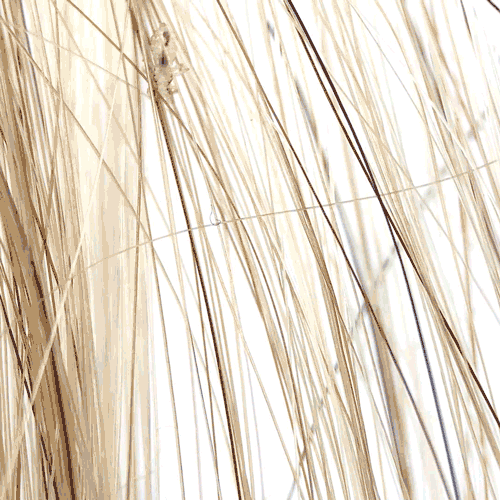
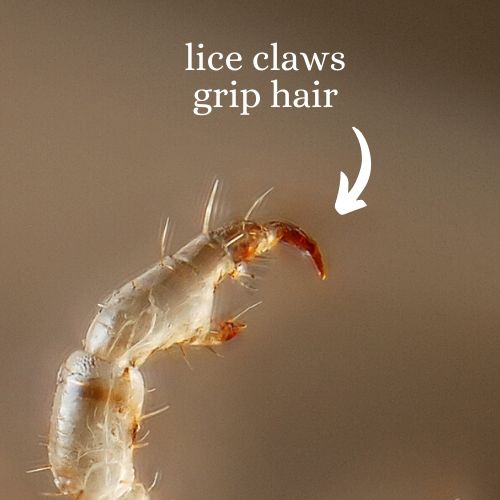
The legs of head lice are designed with claws on the end of each “foot,” designed perfectly to grip hair strands without falling off.
Of course, you can’t see these little claws without a microscope, but you can see them in action. Lice grip onto hair and tightrope walk their way up and down strands easily. If you see a bug maneuvering this easily in hair, it’s certainly lice.
#1 – Lice Color
Let’s get this first myth out of the way right at the beginning. Head lice are not only tan or white. Head lice are a wide variety of colors including dark brown, light brown, tan, gray, red, and even translucent white! You can imagine those mostly transparent lice are especially difficult to see and they are extremely common.
These are all lice I have pulled off people and photographed in my lice center.
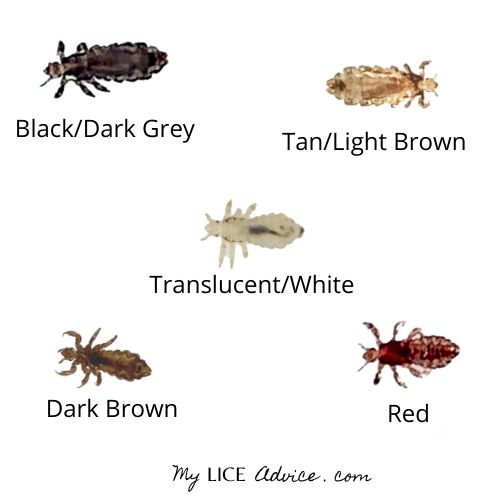
Why Are There Different Colors of Lice?
Newly Hatched...
Head lice are experts at blending in, and that includes blending in with both hair and skin color. When head lice first hatch, they are almost completely see-through.
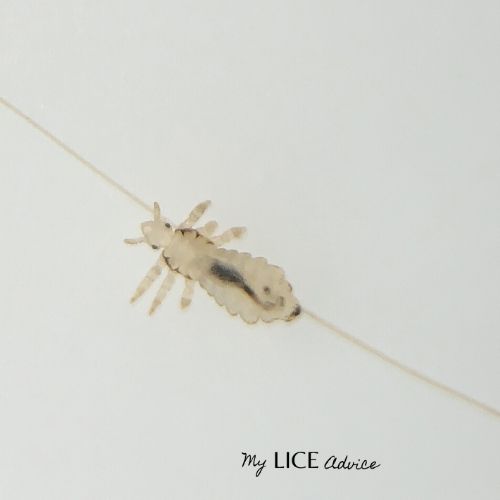
Adult Head Lice...
As lice reach adulthood, they tend to darken in color according to their surroundings. For those with blonde or light brown hair, you’ll typically see tan or light brown adult lice.
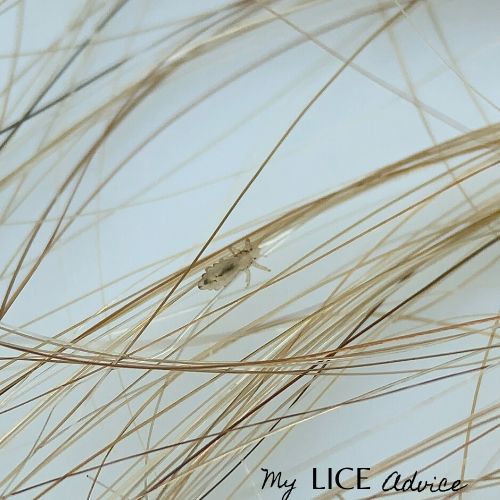
Darker Head Lice...
For those with black hair or dark skin, you’ll typically find dark gray to black lice.
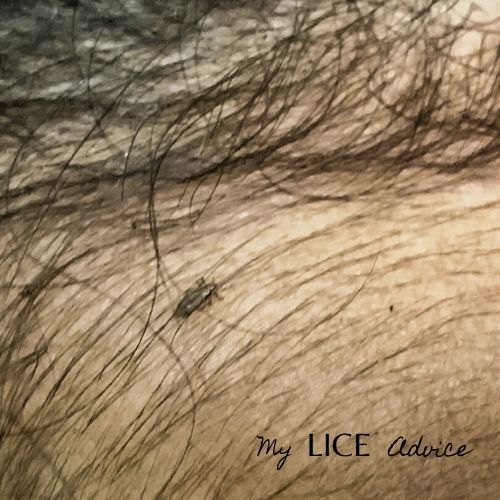
Why Are Some Lice Red?
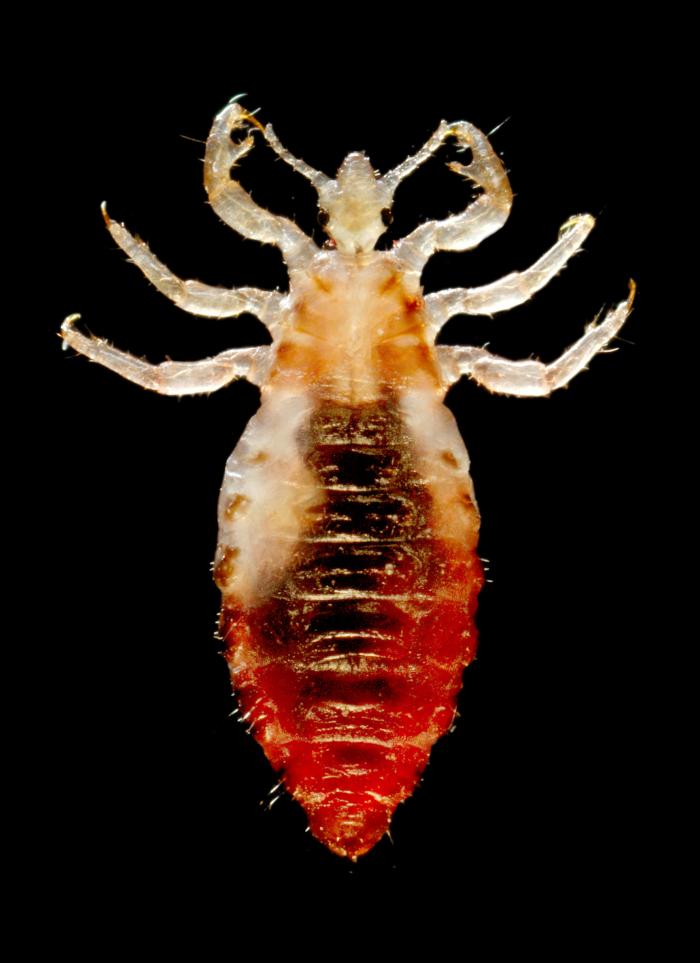
Don’t be terribly horrified if you find a few head lice that are red. Head lice are like vampires, feeding on human blood multiple times a day! In fact, if lice fall off the head and cannot feed on human blood, they usually die within 24 hours.
After lice feed, they get nice and fat on blood. Their stomachs fill up with this blood and their entire abdomen plumps up.
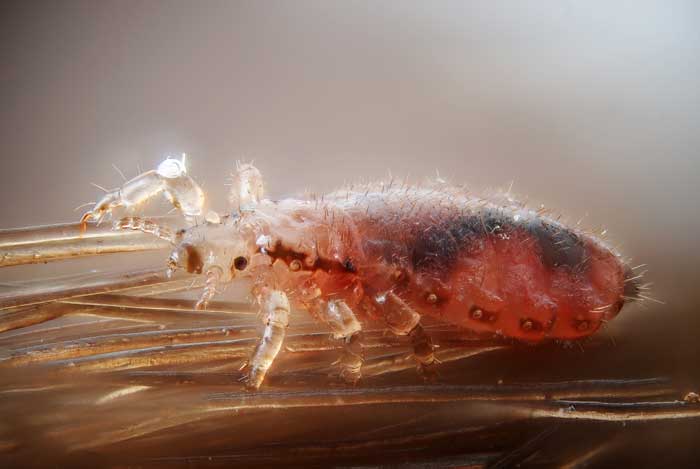
The creepiest part is that the red color seeps into every part of their body. Shortly after feeding, lice appear completely red.
#2 – What Lice Look Like: Shape and Appearance
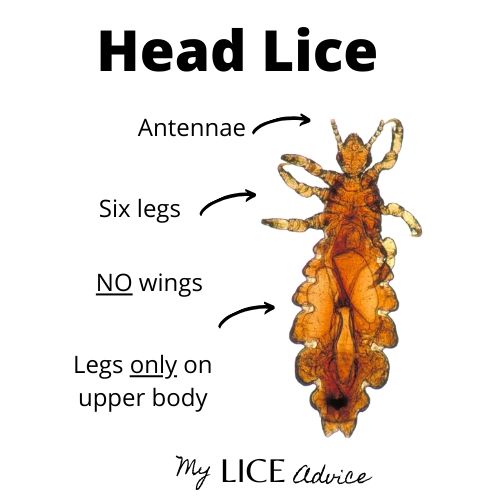
The defining characteristics of both super lice and regular lice are:
- Six legs attached to upper ⅓ of body (not attached to their abdomen)
- No wings
- Varying colored (see above) bodies, darker body as they get older and after they die
- Black stomach/intestines visible through translucent body (larger after feeding)
- Antennae
- Tapered/claw-like legs
Ages and Stages
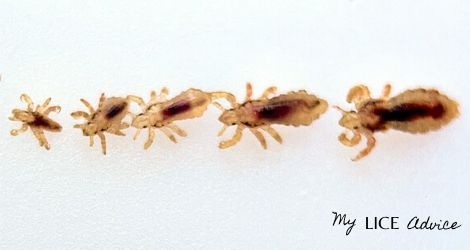
Initially lice are laid in eggs (called “nits”) in the hair, you'll learn about those in the section just below this one. Each lice egg has one lice bug in it, that but hatches in about 7-10 days. When they hatch they are very, very small. Small baby lice are called nymphs. Nymphs have all the same features of adult lice, including 6 legs, but the difference is they are EXTREMELY small, almost invisible to the naked eye. Additionally, they are almost entirely clear (see picture below). Usually the only thing that you can spot on transparent lice is their dark brown or black stomach.
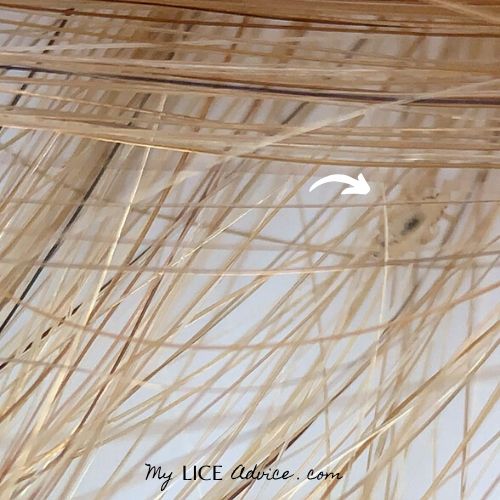
#3: Lice Actual Size
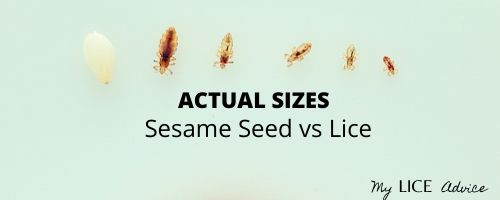
You’ve probably seen lots of pictures of head lice close up, but it can be difficult to determine the actual size of lice from these types of photos. Some sites claim that lice are the size of a sesame seed, but that’s not entirely true. Adult head lice may be the size of a sesame seed (about 3mm long), but nymphs are much smaller, usually closer to only 0.5mm long. It is these very small lice that are so difficult to spot.
For size comparison, here are several different sizes and colors of lice bugs next to an American penny.
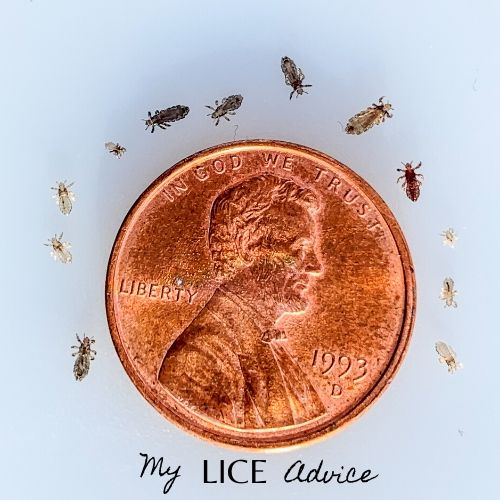
What is the actual size of lice? Here is a lice bug on the tip of a finger.
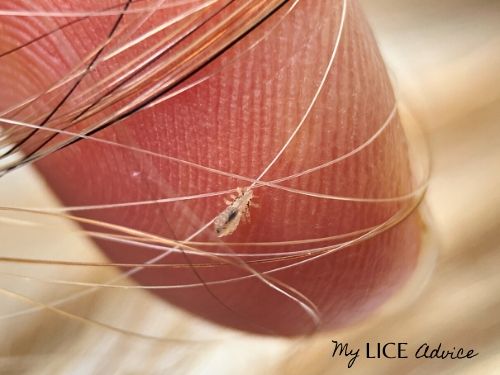
#4: Lice Eggs
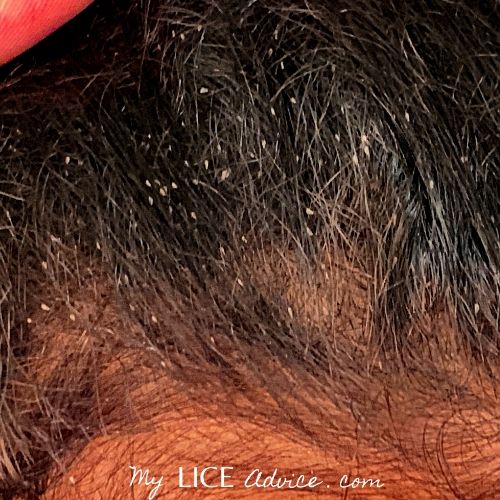
Lice eggs, also known as “nits,” are one of the first signs of a head lice infestation. Lice lay between six and ten of these nits in the hair every day, and it adds up quickly. Nits are often mistaken for dandruff or dirt in the hair because they are small and their shiny appearance can make them look white.
Hot Spots
Nits are most commonly found in the “hot spots” of the head. These hot spots are the places that lice most like to lay their eggs. The hot spots are behind both ears, on the nape of the neck, and on the crown of the head.
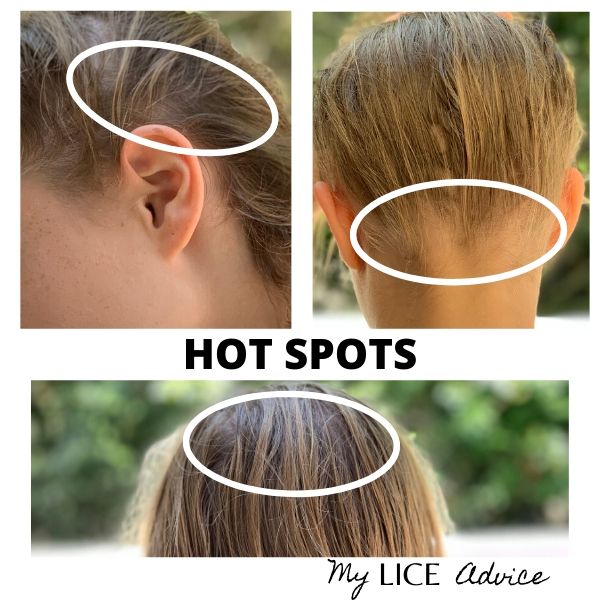
When you're checking for lice, you typically look for lice eggs (also called nits) as opposed to looking for lice bugs. If you want to know how to thoroughly check your child for lice then go to my How to Check Your Child For Lice Tutorial.
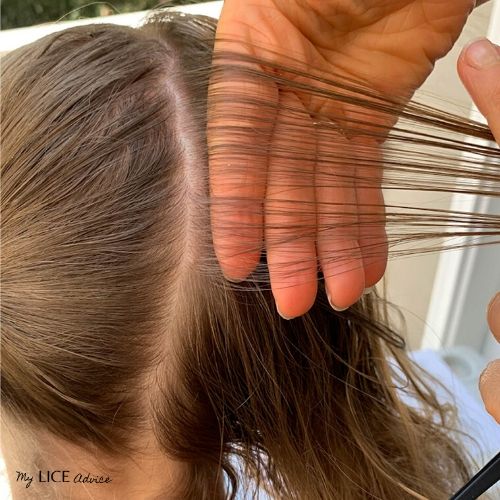
What Lice Eggs (Nits) Look Like
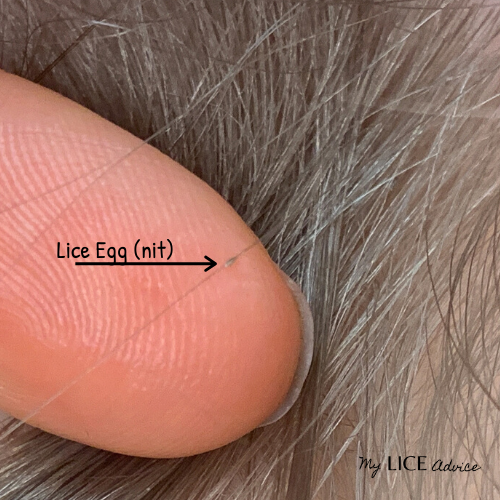
A common misunderstanding is that nits are white. Nits have a shiny appearance and can appear white, especially in dark hair, but most lice eggs are not actually white. They vary in color, from light golden to dark brown, depending on how close they are to hatching. (You can learn more by clicking through to my Dead vs. Live Nits article or my What Lice Eggs (Nits) Look Like article.)
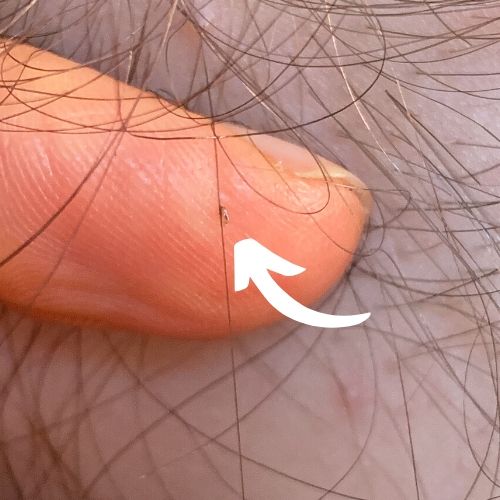
They are extremely small, just a little smaller than a poppyseed. They are also teardrop shaped (not circular) and glued on the side of the hair strand.
The tell-tale sign of nits is that they cannot be flicked, blown, or brushed off. Aside from a high-quality lice comb, the only way to remove a lice egg from the hair strand is to squeeze it between two fingers and manually drag it down the entire strand.
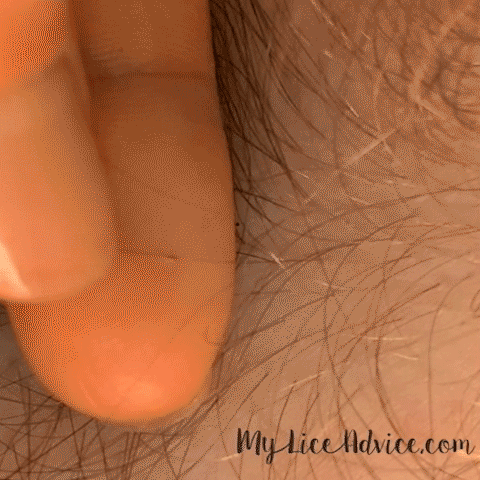
As we discussed above, lice eggs range from golden to very dark brown in color before they hatch. This dark color is the nymph growing inside. After the nymph hatches out of the egg, the eggshell remains on the hair strand and appears “white” in dark hair. Similar to a chicken egg, after you crack open the egg and remove the insides, all you have left is a white shell.
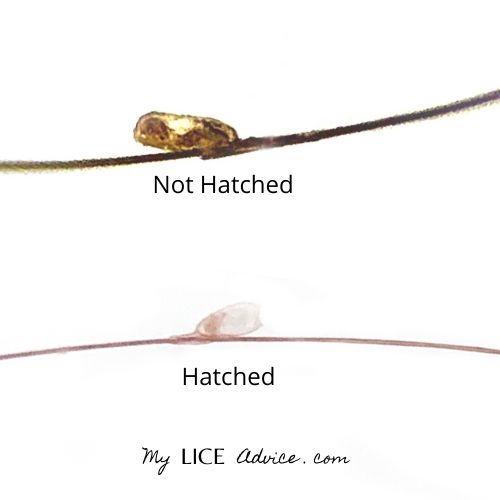
More on Lice Eggs (Nits):
If you’re looking to learn more about lice eggs (nits), check out the articles below:
How to Check Your Child for Lice or
What Lice Eggs and Nits Look Like or
Lice vs Dandruff – 7 Key Difference.
Each of those articles are loaded with pictures of lice eggs.
IF YOU DISCOVER LICE OR LICE EGGS WHEN YOU'RE CHECKING...
The most common mistake parents make is getting a lice kit from the store and thinking that'll take care of the problem. It won't! Most lice today are "super lice" which are immune to those treatments. If you want to get rid of lice quickly, then follow my Step-by-Step Video System.
You follow along with the videos on your child and by the end of the videos your entire family and home are lice free.
#5: Lice Signs & Symptoms
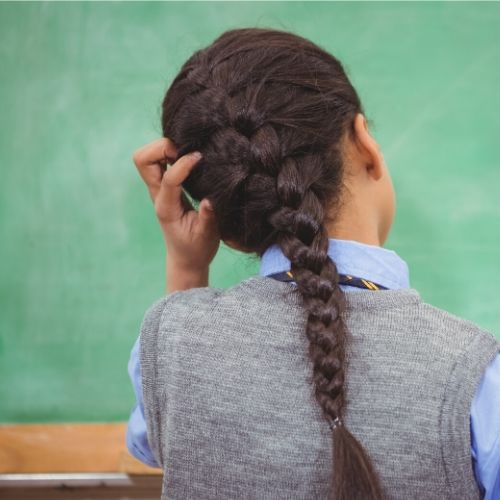
Itchy Scalp (some do, some don’t)
Talking about lice makes most heads itch. (You’re probably itching your head at this very moment). However, when I say “lice cause an itchy scalp,” I’m not talking about a little scratch here and there. After a full month of having head lice, most people’s heads begin driving them crazy. The itch is a deep, internal nagging that you just can’t seem to scratch enough to satisfy.
Most people assume the itchiness is caused by lice moving around on the head, but it is actually the result of an allergic reaction to lice saliva, which is why it takes most people a full month to begin itching.
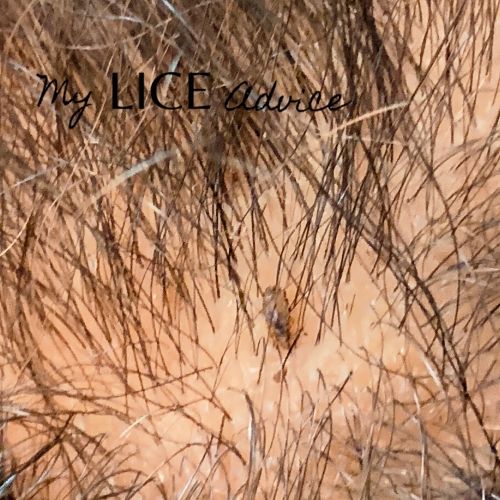
Each time lice feed on your blood, a small amount of their saliva shoots into your scalp. A little bit of this saliva goes unnoticed, but after a month of this repeated feeding, your head develops an allergic response to the lice bites and saliva, which causes these symptoms.
Itching Around the Ears and Neck
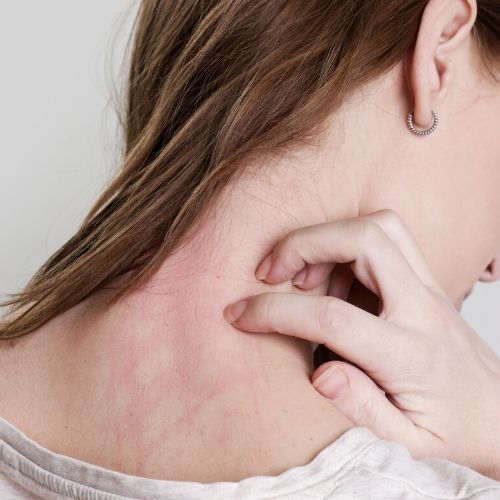
Similar to the deep “itch you just can’t scratch” feeling on the scalp, many people have the same feeling in the hairline near their ears and at their neck. This makes sense when you consider that behind the ears and neck are the “hot spots” where lice prefer to lay their eggs.
Neck Rash or “Lice Bites”
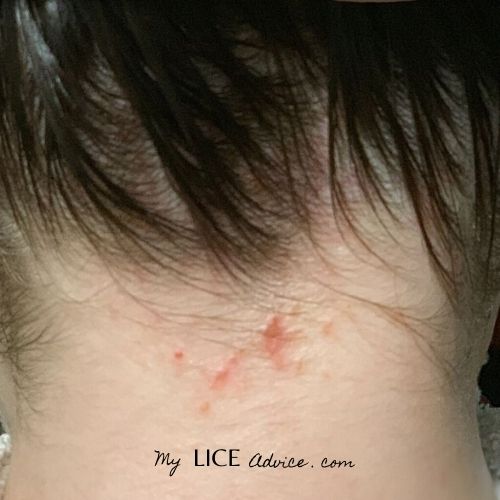
Another sign of lice (also caused by an allergic reaction to lice saliva) is a neck rash or red bumps on the neck. For many people, this sign can show up even before the itching begins. Many people refer to this symptom as “lice bites.”
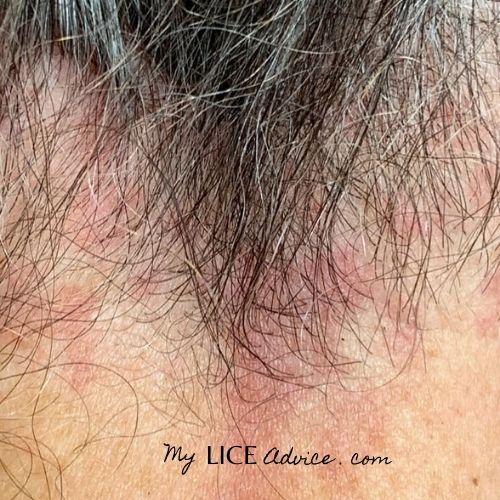
Most commonly, a blotchy, painless (or itchy) rash develops at the nape of the neck in the hair. The rash sometimes spreads to below the hairline at the nape of the neck. More severe neck rashes like this usually itch quite a bit.
Rash Behind the Ears
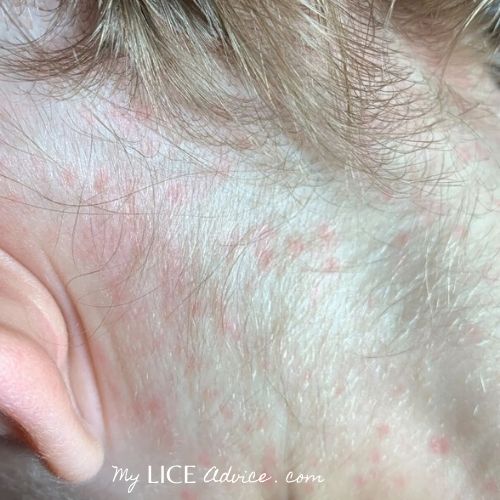
Rashes behind the ears are also quite common. These rashes are typically bright red, blotchy red, or also have a “lice bite” appearance.
Restless at Night, Sleepy During the Day
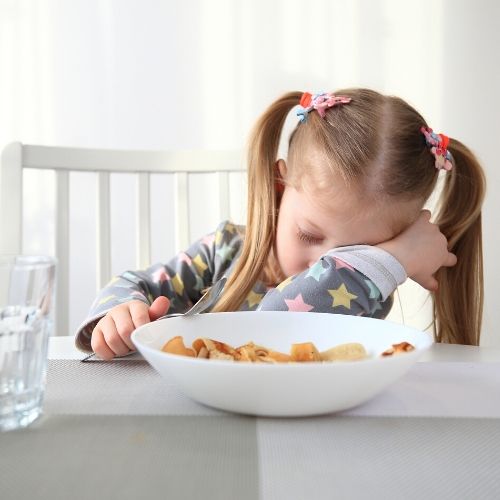
Parents, if you see your child scratching her head frequently while they’re sleeping, it is a tell-tale sign of head lice!
Lice are nocturnal, which means they do most of their moving and feeding at night. This movement and feeding usually increases feelings of discomfort and itching in the night hours. It is not uncommon for someone with lice to “sleep all night,” but wake up completely exhausted because they have been scratching their head all night, which in turn leads to sleepiness and fatigue during the day.
Why Is It So Hard to Get Rid of Lice?
Now that you know what you're looking for I want to talk briefly about your biggest worry (that your child actually has lice) and the question I get asked by parents around the world that have been battling lice….
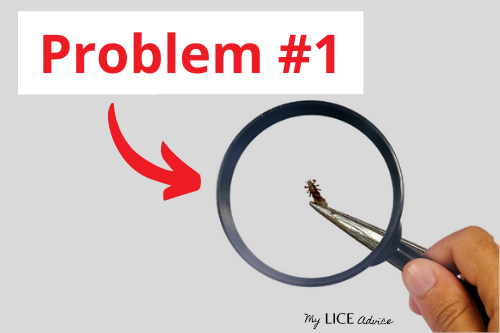
Parents around the world are all asking me the same question…. "Why is it so much harder to get rid of lice now?"
Lice have become immune to everything that used to work in the past. Perhaps you remember your mom using a typical lice treatment or mayonnaise and that doing the trick. The new strain of head lice is no longer killed by those treatments, that’s why lice today are termed by people, “super lice,” because they are immune to those treatments.
I’ve cured thousands of people of lice in my lice center and let me tell you, I don't do it with over-the-counter lice treatments.
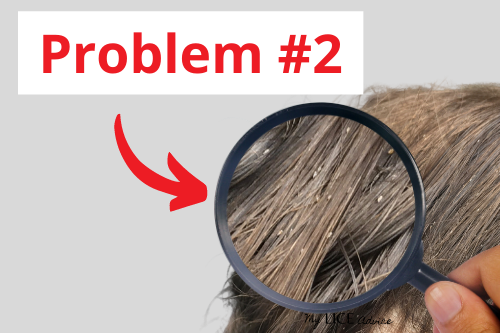
Most people struggle with lice because they focus all of their attention on killing lice bugs and not enough attention on GETTING RID OF LICE!
If you want to get rid of lice you have to address all 3 of the problems of lice:
- Lice Bugs
- Lice Eggs
- Getting Lice Back
The best way to get rid of lice is to tackle all 3 of these problems at the same time, which is what I teach in my step-by-step video system.
So, if you discover your child HAS lice, don't panic. Just head over to the video system. Follow along with the videos and you'll be done with lice by the end of the day.
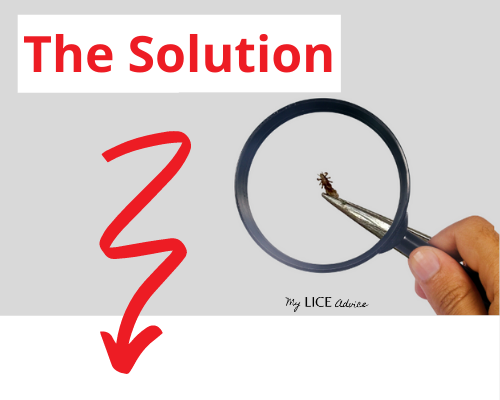

If It's Lice...
If what you are finding is lice, the most important thing for you to remember is that most of today’s head lice are super lice. That means the traditional treatments and pesticides at the store won’t kill them. In fact, the most “popular” treatments are usually among the very worst at killing lice, so don’t be fooled by big name brands or hollow promises of “killing super lice” on the treatment box.
But if it's lice no worries, just head over to the Step-by-Step Video System and be done with lice by the end of the day!
All the best,
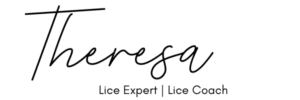

Theresa is a Registered Nurse and lice expert with years of experience curing children of lice. She owns a lice treatment center in the US which is where she perfected the Step-by-Step Video System proven to get rid of lice. She also works with government agencies and schools helping those with the worst head lice cases in America.
Her greatest passion is empowering parents by teaching parents online how to do a professional lice treatment on their child at home. She is the Lice Coach for the My Lice Advice Step-by-Step Video System.

